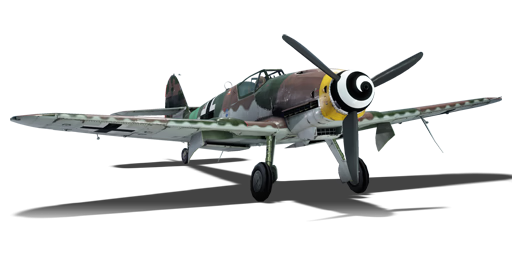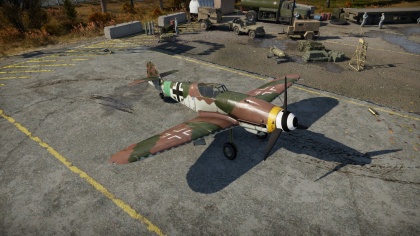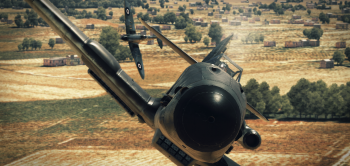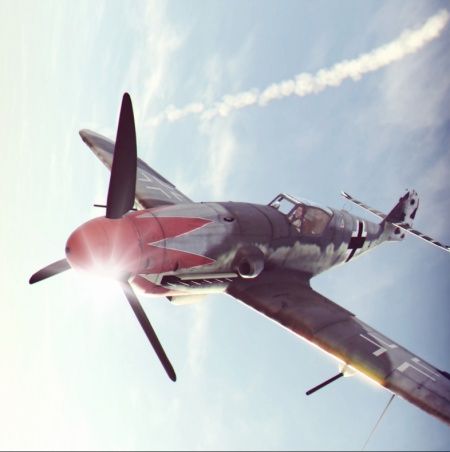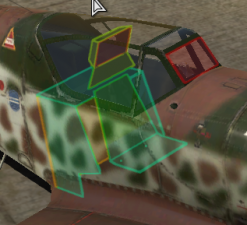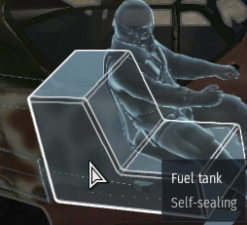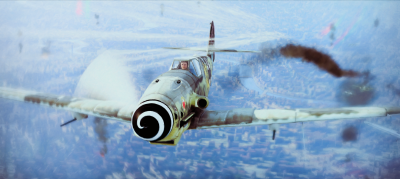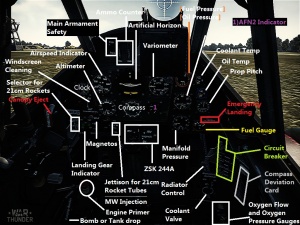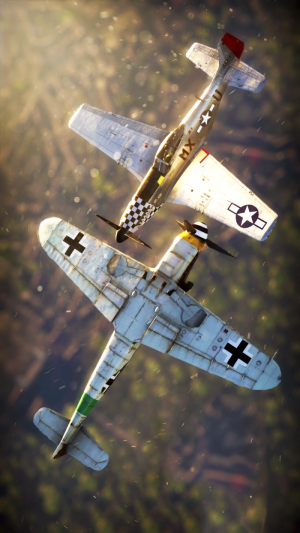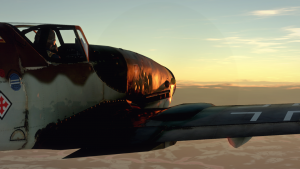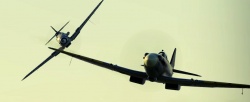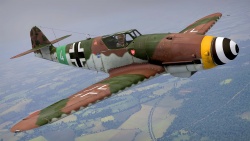Bf 109 K-4
Contents
| This page is about the German fighter Bf 109 K-4. For other uses, see Bf 109 (Family). |
Description
The Bf 109 K-4 is a rank IV German fighter
with a battle rating of 6.3 (AB) and 5.7 (RB/SB). It has been in the game since the start of the Open Beta Test prior to Update 1.27. The K-4 is the pinnacle of the famed 109 series. The 'Kurfürst' frame is the last iteration and was focused on ease of production rather than performance, yet it features the best power to weight ratio and acceleration of any 109, turning this machine into a beast. However, the age of the design is reflected in its poor high-speed characteristics.
Use the plane's outstanding climb rate and speed retention. Energy fighting tactics should be this plane's primary mode of fighting. It has good acceleration when using WEP. This grants the machine reasonable zoom climbing abilities. If chased, dodge away from the enemy with fancy manoeuvres without losing too much speed. In Realistic Battles, try to do a climbing spiral, but be sure to be in a higher energy state than the enemy! A miscalculation and the foe will have the opportunity for an easy deflection shot.
However, there are also downsides. The top speed can be reached quickly, yet the plane is not fast when stock. While it does have an edge in agility, it has bad low-speed manoeuvrability. Furthermore, foes will not usually engage in manoeuvring combat, rendering any manoeuvrability advantage moot.
K-4 can outmanoeuvre these planes at medium speeds (<450 km/h IAS): P-51 (all types), P-47D, Typhoons and the La-9. However, it will have a hard time dealing with other late Rank IV aircraft, especially Spitfires. It is highly recommended to use rudder during rolls as this increases the roll rate dramatically. This is useful if when trying to force an overshoot or when avoiding shots.
General info
Flight performance
For the pilots who flew the Bf 109, it could be a brutal aircraft, with a cramped cockpit and poorly located controls and levers, the pilot could get a serious workout during a dogfight, but don’t think this aircraft is not worth the time as a majority of Germany’s top aces flew Bf 109s. The Bf 109 K-4 was the final iteration of the aircraft, there really wasn’t much more which could have been designed into it to take it any further. In comparison to the early versions which saw combat in the Spanish Civil War, the K-4 was over 300 kph faster at 2,000 m higher than the Bf 109A. The aircraft morphed from a two-bladed wooden propeller to a three-bladed metal propeller with 20 mm or 30 mm autocannons and 13 mm heavy machine guns over two paltry 7 mm machine guns.
The Bf 109 K-4 is meant to dance in the sky with its quick speed, fast rate of climb and excellent energy retention, it can be used to Boom & Zoom in the vertical, unlike many other aircraft which require wide swaths of space to make their attack runs and retreats. The manoeuvrability of the aircraft allows it to make tight turns or quick evasive manoeuvres, especially those which cause a faster and heavier enemy to overshoot and then become the target themselves. To truly compete as a dogfighter and to milk every last bit of speed and manoeuvrability out of the aircraft, the pilot will want to fly it in the clean configuration without the 20 mm gun pods. The gun pods add weight, but for this aircraft, in the worst possible location with one hooked up under each wing. The gun pods mess with the aircraft’s centre of gravity and hamper the manoeuvrability of the aircraft. While it can still fly and fight, the gun pods will make dogfighting a bigger challenge, however, expert pilots may be able to negate some of those factors through sheer skill and luck.
| Characteristics | Max Speed (km/h at 6,000 m) |
Max altitude (meters) |
Turn time (seconds) |
Rate of climb (meters/second) |
Take-off run (meters) | |||
|---|---|---|---|---|---|---|---|---|
| AB | RB | AB | RB | AB | RB | |||
| Stock | 685 | 665 | 12800 | 20.3 | 21.1 | 18 | 333 | |
| Upgraded | 759 | 720 | 18.3 | 19.0 | 32.2 | 23.8 | ||
Details
| Features | |||||
|---|---|---|---|---|---|
| Combat flaps | Take-off flaps | Landing flaps | Air brakes | Arrestor gear | Drogue chute |
| ✓ | ✓ | ✓ | X | X | X |
| Limits | ||||||
|---|---|---|---|---|---|---|
| Wings (km/h) | Gear (km/h) | Flaps (km/h) | Max Static G | |||
| Combat | Take-off | Landing | + | - | ||
| 460 | ___ | 260 | ~13 | ~6 | ||
| Optimal velocities (km/h) | |||
|---|---|---|---|
| Ailerons | Rudder | Elevators | Radiator |
| < 450 | < 390 | < 450 | > 715 |
| Compressor | Optimal altitude | 100% Engine power | WEP Engine power |
|---|---|---|---|
| Setting 1 | 6,900 m | 1,250 hp | 1,775 hp |
Survivability and armour
- 60 mm bulletproof glass in front and rear of the pilot
- Fuel tank with 21 mm steel plate behind it, and 4 mm plates surrounding it
- Pilot's seat has 4 mm steel plates underneath, with 8 mm steel making up the backrest
- 10 mm steel plates surrounding rear bulletproof glass
Willy Messerschmitt’s design of the Bf 109 is known for its very lightweight construction, eliminating any unnecessary devices, parts and even structural spars to allow for the fastest that this fighter could be and still be a strong fighter. Part of this challenge was ensuring there was enough protection for the pilot and certain critical components without overburdening the aircraft and make it sluggish with the addition of too much armour. For this aircraft, it makes sense that all of the armour is centred around the pilot as this serves two purposes, aid in the protection of the pilot and two, protecting the fuel tank which the pilot literally sat on top of.
The pilot’s protection from the front comes mainly from the 60 mm bulletproof glass windscreen, headrest and various plates of armour between 4 and 10 mm in thickness which makes up the seat and headrest. These plates aid in protecting the pilot from both frontal attacks generally associated from attacking bombers with defensive positions and also from the rear when being chased by an enemy fighter. Though the fuel tank is self-sealing when it has been shot, 4 mm and 20 mm steel plating also surrounds the tank as the first line of defence against enemy machine gun rounds, however, incoming 20 mm rounds may not have any problems getting through.
When attacking a Bf 109 K-4, unless you can aim autocannon shots to blow off a wing, the best bet will be to aim for the fuselage starting from right behind the pilot all the way to the propeller. Hitting within this range will allow you to hit one of the vital components of the aircraft to include the fuel tank, the pilot, any of the coolers or the engine itself. The most successful attacks will happen from underneath the aircraft or from the sides where there is no armour protection. If however, you find yourself tailing a Bf 109 K-4, use short bursts to spook the pilot into manoeuvring where they end up exposing the large surface areas of the aircraft and then unload where the rounds will have less chance to ricochet and more chances of taking out this aircraft.
Armaments
Offensive armament
The Bf 109 K-4 is armed with:
- A choice between two presets:
- 1 x 30 mm MK 108 cannon, nose-mounted (65 rpg) + 2 x 13 mm MG 131 machine guns, nose-mounted (300 rpg = 600 total)
- 1 x 20 mm MG 151 cannon, nose-mounted (200 rpg) + 2 x 13 mm MG 131 machine guns, nose-mounted (300 rpg = 600 total)
As was typical of Bf 109s was having a motorkanone mounted to shoot through the propeller hub. Typically these aircraft were outfitted with a 20 mm autocannon, which pilots of earlier 109s will have already had experience with, however, the Bf 109 K-4 provides the pilot with the option to choose their motorkanone of choice, either a 20 mm MG 151 or a 30 mm MK 108. In real life, the 30 mm autocannon tended to jam during combat and can do the same in-game, until that is the module is upgraded and jamming frequency will lessen. For the most part, the difference between the 20 and 30 mm autocannons is power vs. ammunition count.
The 30 mm round is a slow but deadly round and when fired at close range it can have devastating results on its target. A large disadvantage due to its size and weight only carries 65 rounds which make it necessary for the pilot to exercise disciplinary control and only fire when they are sure the rounds will hit. On the other hand, the 20 mm, though powerful in their own right, will not have the same heavy-hitting power as the 30 mm rounds, however, the Bf 109 K-4 can carry 200 of these rounds and they travel faster and can be fired more rapidly. Typically if the Bf 109 K-4 pilot is going to play the role of a bomber interceptor, the 30 mm round will be most effective, however, if the choice is made to be a fighter/attacker interceptor, then the 20 mm motorkanone will probably be the best bet.
While a choice is necessary between the two cannons as to which to take, regardless of the choice, the pilot will also have two 13 mm heavy machine guns which are mounted on the top of the fuselage engine cowling. Having 300 rounds per gun will allow the pilot to continue to spew out damage even when the autocannons have run dry. Another option is to separate the firing control for the autocannons and the heavy machine guns and instead track and fire enemy targets with the machine guns, utilize them as range finders and when the pilot sees they have a good firing solution, they can then employ the autocannons, thereby saving valuable ammunition and ensuring there is enough there when it is needed.
Suspended armament
The Bf 109 K-4 can be outfitted with the following ordnance:
- Without load
- 2 x 20 mm MG 151 cannons, wing-mounted (135 rpg = 270 total)
There are a few aircraft which are featured in War Thunder which becomes a monster aircraft when they utilise gun pods to increase their firepower. The Bf 109 K-4 is no exception, especially considering that it’s gun pods contain a single 20 mm MK 151 autocannon, each of which holds 135 rounds of ammunition. Attacking enemy aircraft with three autocannons and two machine guns can cause devastating results, however, with these gun pods, the pilot will need to calculate for convergence so as not to waste ammunition. While the fuselage weapons fire straight forward, the underwing cannons will need to be adjusted to converge at the correct point where the pilot typically shoots down enemy fighters. A convergence set too far may mean a number of the rounds will easily miss the enemy aircraft while setting the convergence zone too close will do the same. The gun pods are not required for the pilot to take while leaving them behind at the hanger, the pilot will not have to worry about the decrease in performance with the weight out on the wings and will have increased manoeuvrability that they would have otherwise not had were there gun pods mounted.
Usage in battles
The MK 108 is a double-edged sword: Nicknamed by the allies for its characteristic sound, the `Jackhammer´ lives true to its name. Slow but powerful. Its main purpose: Demolition of heavy objects, such as the B-17G Flying Fortress. However, its common purpose in War Thunder remains to hunt fighter planes. The cannon's rate of fire is extremely low, making it good for conserving ammo, but bad for deflection shots. Furthermore, the minengeschoß-shells are slow- very slow. One must either become very good at leading the shells or close the distance. Kills are generally done from 300 meters away, if not closer. On the plus side, the damage is equivalent to most 37 mm cannons upon hitting. Tip: In order to better learn and understand the cannon's trajectory, do not fire in conjunction with the machine guns.
The two additional machine guns are best fired alone. The MG 131 features HE shells (named IAI in-game) as the Tracer belt. Yet they are only highly effective in Simulator battles, where they will deal good damage to control surface areas, causing inexperienced pilots to lose control. In Arcade and Realistic battles, however, the instructor will dampen any such effects. Here, the damage-based Stealth and Fighter belts fare better.
The plane should equip one of two load-outs: with either the single 30 mm cannon or 2 x 20 mm cannons. The single 30 mm is very capable of taking out 2-3 bombers and the low muzzle velocity matters less due to the large targets. The 3 x 20 mm cannons are very capable of taking out fighters due to the high shell density and sheer damage output. A single 20 mm does not deal enough damage and the 30 mm with gun pods is rather ineffective due to the differing muzzle velocities of the 30 mm and 20 mm cannons.
One technique you can use is the prop pitch technique. Most of the later 109s have this but it is really effective in the 109 K-4. The prop pitch technique is using Manual Engine Control (found in sim controls) to set your prop pitch to 100% but throttle to 0%. This will make your prop, a giant air brake and is very helpful in forcing overshoots of the enemy aircraft. It can also be very helpful in diving where you might get dangerously close to your rip speed.
Manual Engine Control
| MEC elements | ||||||
|---|---|---|---|---|---|---|
| Mixer | Pitch | Radiator | Supercharger | Turbocharger | ||
| Oil | Water | Type | ||||
| Not controllable | Controllable Auto control available |
Controllable Auto control available |
Controllable Auto control available |
Separate | Not controllable 1 gear |
Not controllable |
Modules
| Tier | Flight performance | Survivability | Weaponry | ||
|---|---|---|---|---|---|
| I | Fuselage repair | Radiator | Offensive 13 mm | MG.151/20 cannon | |
| II | Compressor | Airframe | New 13 mm MGs | R4 modification | |
| III | Wings repair | Engine | Offensive 30 mm | Offensive 20 mm | |
| IV | Engine injection | Cover | New 30 mm cannons | New 20 mm cannons | |
The true acceleration power of the plane is only achieved very late into the grind. Specifically, the Tier 4 Engine injection modification provides a significant boost and is a top priority. On the way there, all engine upgrades should be taken. 13 mm belts are helpful for removing tracer rounds. The 20 mm gun pods with belts and the gun upgrade are viable choices but engine injection remains a priority.
Pros and cons
Pros:
- Very powerful engine when using WEP, providing excellent acceleration and climb rate
- Manual engine control can extend the climb rate and top speed in realistic and simulator battles
- Nose mounted weaponry
- Good performance at medium altitude
- Good firepower for destroying larger attackers and bombers
- Can carry additional armament
- Performance on par with Griffon Spitfires (even better when fully upgraded)
- 30 mm cannon will usually destroy anything that it hits
- Can research nose-mounted 20 mm MG 151 cannon, which makes deflection shooting much more reliable
- Exceptional high-speed manoeuvrability
Cons:
- Low cannon ammunition count for the 30 mm MK 108 cannon and the 13 mm MG 131 machine guns
- Low velocity 30 mm shell with a high drop, resulting in a VERY large lead angle on targets in turn leading to poor dogfight performance due to having to pull extreme turns to get guns on target
- Flimsy airframe, prone to react heavily to damage
- When aircraft is stock, very heavy and slow to fly without WEP
- Stock 13 mm machine gun belts consist solely out of tracers which alerts enemy, makes aiming 30 mm difficult
- Fighters with lower top speeds but better low altitude performances (such as Russia's La-7 fighters) will find it quite easy to run down the K-4 when at a low energy state
- Very slow deploying flaps
History
Design and development
Throughout the 1920s and 1930s, the Luftwaffe (German Air Force) moved ahead at break-neck speeds to develope civilian aircraft which secretly doubled as military fighters and bombers requiring only minor modifications to become war-fighter operational. Aircraft designated as transport and airline variants could easily be converted to bombers and the initial Bf 109 was no different in its purposes. The birth of the Bf 109 started out as a requirement from Herman Göring, Reichsminister of Aviation proposed to newly appointed Theo Croneiß of Bayerisch Flugzeugwerke (BFW, Bavarian Aircraft Works). The requirement was for a single-seat high-speed courier plane, obviously, one which could be converted into a fighter when the time required. At the same time this requirement went out, the Reichsluftfahrtministerium’s (RLM, Reich Aviation Ministry) Technisches Amt (C-AMT) or technical department was tasked with projecting aircraft requirements for potential future air combat and of the four main types determined to be essential, single-seat fighter requirements were published as L.A. 1432/33.
These fighter requirements were as follows:
- Top speed – 400 kph (250 mph) at 6,000 m (19,690 ft) maintained for 20 minutes
- Total flight duration – 90 minutes
- Critical altitude of 4,000 m reached within 17 minutes
- Operational ceiling – 10,000 m (32,810 ft)
- Armed with 1 x 20 mm motorkanone and two 7.92 mm machine guns
- Rated performance in the order of: level speed, rate of climb and maneuverability
During the early years of BFW, Willy Messerschmitt was the designer of the transport aircraft the BFW M.20, however due to several high-profile crashes of these transport aircraft, one of which included test pilot Hans Hackmack, a close friend of Erhard Milch (at the time, head of Luft Hansa and the German civil aviation authorities). With Erhard Milch, a lifelong hatred developed when Messerschmitt responded very callously to events about the crash. During this time, BFW went bankrupt and Messerschmitt went to work designing aircraft for a Romanian airline company. At the time requirements for L.A. 1432/33 were published, Messerschmitt was called back to Berlin and basically told his efforts were to be used for the Fatherland. Messerschmitt acquiesced and was given the specifications for the potential fighter, which after review, he proceeded to relate a very unfavourable opinion of the fighter as if built as described, the fighter would be literally obsolete as it rolled off the assembly line and unable to catch up to even medium bombers. After hearing the report and seeing the truth in Messerschmitt's words, the Technisches Amt awarded BFW the contract to build a fighter aircraft and Willy Messerschmitt was given free rein over the design of the aircraft.
Messerschmitt began design of the P.1034 (later known as Bf 109), and much like its older transport sibling the Bf 108, the new fighter was developed based on Messerschmitt’s lightweight construction principle, the basis of this principle was to minimize the number of separate parts located on the aircraft, which would speed up construction and add in ease of maintenance. For example, many of the main connection points for the airframe, engine frame and wings all had their connecting load points all at the firewall. Another example was having the landing gear attached to the fuselage and not the wings, which allowed for removal of the wings without having to support the aircraft on jack-stands and also reduced the stress on the wing loads during takeoff and landing. One tell-tale sign of a Bf 109 is the landing gear slightly splayed outwards and this was to increase the stability of the aircraft while taxiing on the ground by providing a wider track, making it less prone to flipping over.
Forethought was put into the aircraft especially for mechanics which would service the aircraft on the front-lines of battle. The entire engine cowling, weapon hatches, and other maintenance access panels could be removed allowing the mechanics full access to service, repair and even replace critical parts on the aircraft with little difficulty. Pipe connections were colour-coded and electrical cabling plugged into junction boxes, typically an old engine could be disconnected, removed, replaced with a new engine and all connections resecured in a matter of minutes, something unheard of in most military aircraft of the time.
While a high-speed requirement would necessitate a small wing to decrease surface area, Messerschmitt knew this would require a more powerful engine to generate enough lift to maintain flight. The wings of the Bf 109 had several modifications which would compensate for these issues to include high-lift devices such as automatically-opening leading edge slats and trailing edge flaps which had a large camber to allow for a significant increase of lift when deployed. To help increase the overall flap effectiveness, the ailerons would also "droop" to aid in the flaps work. The weapons for the aircraft were all centrally located in the fuselage, with the large cannons mounted in the propeller hub and the machine guns located in the upper fuselage. Leaving these out of the wings allowed for significant manoeuvrability with all of the heavy equipment kept along the centerline of the aircraft leaving the wings to be very thin and light.
Messerschmitt was ahead of his time, this was noted when the Bf 109 went to trials. Most experienced military pilots were seasoned World War I pilots who spent their time flying biplane fighters such as the He-51, aircraft with two sets of wings, open cockpit, low wing loading and light g-forces, one look at the new Bf 109 produced sour reactions, especially from stunt and ace pilot Ernst Udet. At first glance, Udet had serious doubts about the Bf 109 and requested directly from Messerschmitt to remove the canopy to allow the pilot to judge the aircraft’s speed through the air stream and to add a second wing with struts and wires, otherwise, the aircraft was destined to fail as a fighter. Udet’s initial test flight of the Bf 109 drastically changed his opinion of the revolutionary new fighter, forever changing how Germany designed and manufactured their fighters.
Throughout the years, the Bf 109 with through many iterations involving upgrades and fine-tuning. The last of the series was the Bf 109 K series, also known as Kurfüst. Unfortunately for this series, it was a compilation of model upgrades, modification kits and factory conversions which ultimately made both the production and maintenance of this aircraft a literal nightmare in both cost and complication with its maintenance. Due to problems with the series production and the lateness of the war when it entered, the K-4 model was the only version to be mass-produced. External changes included movement of the radio equipment hatch, fuselage fuel tank filler point, movement of the direction-finding loop and a retractable tail-wheel with clam-shell doors. Armament would include a 30 mm motorkanon and 2 x 13 mm machineguns with options to attach bombs or 20 mm cannon gondola pods, however, the suspended armament was rarely utilised. Between November 1944 and March 1945, a total of 1,593 Bf 109 K-4 fighters were produced, one in four Bf 109s listed in front line fighting units was the Bf 109 K-4. Unfortunately at this point in the war, the Bf 109 K-4 had two things going against it, first was the appearance of jet fighters which nullified any advantages the K-4 had achieved and secondly, the hastily trained novice pilots at this point of the war could not exploit the K-4’s advantages which would eventually come from experience.
In-game description
The Messerschmitt Bf 109 was a single-seat monoplane fighter used by the Luftwaffe before and during WWII. It was used as a fighter, interceptor, high-altitude interceptor, fighter-bomber and reconnaissance aircraft.
The Bf 109K "Kurfuerst" was the last mass-produced variant of the Bf 109 family. It first reached front-line units in September 1944 (or early 1945, according to other data). The fighter was powered by the Daimler-Benz DB 605 DCM engine and had more powerful armament, with some variants equipped with two 15mm or three 30mm cannon.
Media
- Images
- Videos
See also
- Aircraft of comparable role, configuration and era
- Mitsubishi A6M
- Fiat G.55
- IAR-81
- Kawasaki Ki-61
- Nakajima Ki-43
- North American P-51 Mustang
- Supermarine Spitfire
- Yakovlev Yak-9
External links
- [Chuckhawks.com website ] The Best Fighter of its Generation (1935-1945): Messerschmitt Bf 109
- [Luftkrieg-ueber-europa.de website ] How good was the Messerschmitt Bf 109?
- [Kurfurst.org website ] Kürfurst - The Messerschmitt Bf 109 Performance Resource Site
| Germany fighters | |
|---|---|
| Heinkel | |
| He 51 | He 51 A-1 · He 51 B-1 · He 51 B-2/H · He 51 C-1 · He 51 C-1/L |
| He 100 | He 100 D-1 |
| He 112 | He 112 A-0 · He 112 B-0 · He 112 B-1/U2 · He 112 B-2/U2 · He 112 V-5 |
| Messerschmitt | |
| Bf 109 (Jumo) | Flegel's Bf 109 A · Bf 109 B-1 · Bf 109 C-1 |
| Bf 109 (DB-601) | Bf 109 E-1 · Bf 109 E-3 · Bf 109 E-4 · Bf 109 E-7/U2 · Bf 109 F-1 · Bf 109 F-2 · Bf 109 F-4 · Bf 109 F-4/trop |
| Bf 109 (DB-605) | Bf 109 G-2/trop · Bf 109 G-2 · Bf 109 G-6 · Bf 109 G-10 · Bf 109 G-14 · Bf 109 K-4 |
| Focke-Wulf | |
| Fw 190 (early) | Fw 190 A-1 · Fw 190 A-4 · Fw 190 A-5 · Fw 190 A-5 · Fw 190 A-5/U2 · Fw 190 A-5/U14 · Fw 190 A-8 · Fw 190 C |
| Fw 190 (late) | Fw 190 D-9 · Fw 190 D-12 · Fw 190 D-13 |
| Ta 152 | Ta 152 C-3 · Ta 152 H-1 |
| Blohm & Voss | |
| BV 155 | BV 155 B-1 |
| Foreign: | |
| USA | ▀P-47D-16-RE · ▀P-47D |
| USSR | ▀La-5FN · ▀Yak-1B |
| Britain | ▀Tempest Mk V |
| Italy | ▀CR.42 · ▀Marcolin's C.R.42 CN · ▀G.50 serie 2 · ▀G.50 AS serie 7 · ▀C. 200 serie 3 · ▀C. 200 serie 7 · ▀C. 202 |
| Finland | ▀Hawk H-75A-2 |


